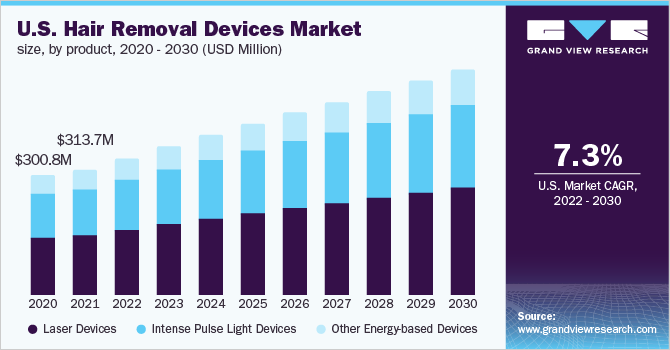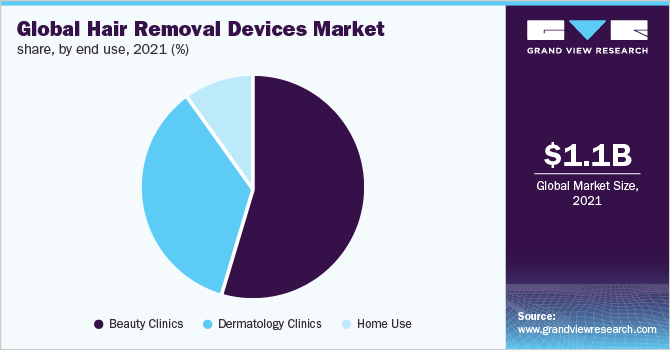- Home
- »
- Medical Devices
- »
-
Hair Removal Devices Market Size Report, 2022-2030GVR Report cover
![Hair Removal Devices Market Size, Share & Trends Report]()
Hair Removal Devices Market Size, Share & Trends Analysis Report By Product (Laser Devices, Intense Pulse Light Devices), By End Use (Beauty Clinics, Dermatology Clinics, Home Use), And Segment Forecasts, 2022 - 2030
- Report ID: GVR-2-68038-710-0
- Number of Report Pages: 80
- Format: PDF, Horizon Databook
- Historical Range: 2017 - 2020
- Forecast Period: 2022 - 2030
- Industry: Healthcare
Report Overview
The global hair removal devices market size was valued at USD 1,083.83 million in 2021 and is anticipated to expand at a compound annual growth rate (CAGR) of 8.6% during the forecast period. There was a fall in the global market in 2020 due to the COVID-19 pandemic. The rise in beauty consciousness and growth in awareness about enhancing esthetic appeal are among the factors boosting the market. The COVID-19 pandemic had adversely impacted the beauty industry. The lockdown and restrictions have changed the purchase and usage behavior across the beauty and personal care space, which has resulted in a decrease in sales across many beauty segments.

However, the market is still recovering as some restrictions have been lifted and the spread of the virus is also declining. The growing awareness among people pertaining to their physical grooming and esthetics has led to high product demand. In the current scenario, people are highly concerned about their physical appearance. With the rise in disposable income levels, spending on personal care products is also increasing. This has boosted product sales. In addition, with the introduction of advanced products, the preference for noninvasive techniques for personal grooming is increasing. Potential risks associated with invasive procedures for improving esthetic appeal have led to the high demand for non-invasive or non-surgical techniques.
There has been an increase in the availability of technologically advanced products. For instance, there have been consistent improvements in laser techniques, which have increased their efficiency and cost-effectiveness. Thus, benefits associated with the use of technologically advanced products are motivating people to use these tools. However, the high costs of laser products are expected to be an obstacle for people in developing regions. For instance, hair removal treatment on legs costs around USD 800 for a single session. This factor impacts their purchasing power, thereby leading to sluggish growth in developing regions.
Product Insights
On the basis of products, the market has been divided into laser devices, intense pulse light devices, and other energy-based devices. The laser devices segment accounted for the largest share of more than 45.0% of the global revenue in 2021, owing to the wide usage of these products on account of their rapid treatment results. They have proven to be safer for all skin tones & hair colors and facilitate less painful treatment procedures. With technological advancements, these products are expected to dominate the market even during the forecast period. Laser devices are sub-segmented into Nd: YAG, diode, and alexandrite laser systems.
Intense pulse light devices generated the second-highest revenue in 2021 due to the growth in their usage as home-use devices. On the other hand, these systems have multiple wavelengths that aid in scattering within the patient’s skin. Thus, they are considered less effective as compared to laser devices due to the light produced by them. Other energy-based devices include light heat energy, which is effective on all types of skin tones. However, despite the advantages associated with dual-energy, they have low intensity as compared to other technologies used for hair removal; due to this, the segment is expected to exhibit sluggish growth in the coming years.
End-use Insights
On the basis of end uses, the global market has been segmented into beauty clinics, dermatology clinics, and home use. The beauty clinics segment dominated the market in 2021 and accounted for the maximum revenue share of more than 54.00%, as a high number of people prefer to undergo hair removal procedures at beauty clinics. In addition, people prefer visiting beauty clinics to undergo other procedures to improve their aesthetic appeal. Beauty clinics are well equipped with advanced products with the latest technologies, due to which, people opt for treatments in these clinics.

Moreover, a rise in the number of beauty clinics in developed as well as developing countries due to the high demand for these facilities will support the growth of this segment during the forecast period. Dermatology clinics held the second-largest market share in 2021 due to the expertise offered by dermatologists in these settings, which is often more specific and thus, allows patients to evaluate various available treatment options. These clinics provide more practical and comprehensive information for treating skin disorders. People often visit expert practitioners at these clinics for initial consultation sessions before opting for a suitable process.
Regional Insights
North America dominated the market in 2021 and accounted for the maximum share of more than 35.5% of the global revenue. Easy availability of technologically advanced products and high awareness levels among consumers about physical grooming are some of the major factors responsible for the growth of the regional market. An increase in the usage of laser hair removal devices for rapid and effective results in the U.S. is among the key factors contributing to the country’s dominance in the North American regional market. Manufacturers in this region are majorly focusing on the development, commercialization, and distribution of hair removal products that cater to the needs of healthcare professionals, especially dermatologists, and patients.
Growth in the popularity of hair removal treatments and the availability of skilled dermatologists in European countries are the factors anticipated to foster the product demand in this region. The Asia Pacific regional market is expected to register the fastest growth over the course of the forecast period. This can be attributed to an increase in the demand for cost-effective hair removal products and a rise in disposable income levels in this region. The rising awareness regarding the safety offered by laser devices is also expected to fuel the product demand, thereby augmenting the regional market growth. Rapid technological advancements in this region will further boost the market growth. Rising beauty consciousness, especially in developing countries, has also created untapped opportunities in the APAC regional market.
Key Companies & Market Share Insights
The global industry has witnessed increased competition on account of the rapid growth in the number of North American and Asian manufacturers. Key companies are continuously focusing on initiatives, such as mergers & acquisitions, regional expansions, and novel product development, to gain a higher market share. For instance, in November 2019, Venus Concept Inc. announced a merger with Restoration Robotic, Inc. This is likely to create a leading global medical aesthetics company to commence trading. Some of the major players in the global hair removal devices market are:
-
Solta Medical, Inc.
-
Cynosure, Inc.
-
Lumenis
-
Venus Concept Canada Corp.
-
Alma Lasers
-
Lutronic
-
Cutera
-
Syneron Medical Ltd.
-
Sciton, Inc.
-
Viora
-
Panasonic Corporation
-
Home Skinovations Ltd
-
Procter & Gamble Company
-
iluminage Beauty Inc.
-
Koninklijke Philips N.V
-
Dermacell Private Limited
-
LASERBIO OPTOTECH LLP
Hair Removal Devices Market Report Scope
Report Attribute
Details
Market size value in 2022
USD 1.2 billion
Revenue forecast in 2030
USD 2.1 billion
Growth rate
CAGR of 8.6% from 2022 to 2030
Base year for estimation
2021
Historic data
2017 - 2020
Forecast period
2022 - 2030
Quantitative units
Revenue in USD Million/Billion and CAGR from 2022 to 2030
Report coverage
Revenue forecast, competitive landscape, growth factors, and trends
Segments covered
Product, application, end-use, distribution channel, region
Regional scope
North America; Europe; Asia Pacific; Latin America; & MEA
Country scope
U.S.; Canada; U.K.; Germany; France; Italy; Spain; Japan; India; China; Australia; South Korea; Brazil; Mexico; South Africa; Saudi Arabia
Key companies profiled
Solta Medical Inc.; Cynosure Inc.; Lumenis; Venus Concept Canada Corp.; Alma Lasers; Lutronic; Cutera; Syneron Medical Ltd.; Sciton Inc.; Viora; Panasonic Corporation; Home Skinovations Ltd; Procter & Gamble Company; iluminage Beauty Inc.; Koninklijke Philips N.V; Dermacell Private Limited; LASERBIO OPTOTECH LLP
Customization scope
Free report customization (equivalent up to 8 analysts working days) with purchase. Addition or alteration to country, regional, and segment scope.
Pricing and purchase options
Avail customized purchase options to meet your exact research needs. Explore purchase options
Segments Covered in the Report
This report forecasts revenue growth at global, regional, and country levels and provides an analysis of the latest industry trends in each of the sub-segments from 2017 to 2030. For the purpose of this study, Grand View Research has segmented the global hair removal devices market report on the basis of product, application, end-use, distribution channel, region:
-
Product Outlook (Revenue, USD Million, 2017 - 2030)
-
Laser Devices
-
Diode Laser
-
Nd: YAG Laser
-
Alexandrite Laser
-
-
Intense Pulse Light Devices
-
Other Energy-based Devices
-
-
Application Outlook (Revenue, USD Million, 2017 - 2030)
-
Facial Hair Removal
-
Legs
-
Hands
-
Others
-
-
End-use Outlook (Revenue, USD Million, 2017 - 2030)
-
Beauty Clinics
-
Dermatology Clinics
-
Home Use
-
-
Distribution Channel Outlook (Revenue, USD Million, 2017 - 2030)
-
Supermarkets and hypermarkets
-
Drug-stores
-
Online
-
-
Regional Outlook (Revenue, USD Million, 2017 - 2030)
-
North America
-
U.S.
-
Canada
-
-
Europe
-
Germany
-
U.K.
-
France
-
Italy
-
Spain
-
-
Asia Pacific
-
Japan
-
China
-
India
-
Australia
-
South Korea
-
-
Latin America
-
Brazil
-
Mexico
-
-
MEA
-
South Africa
-
Saudi Arabia
-
-
Frequently Asked Questions About This Report
b. The global hair removal devices market size was estimated at USD 1,083.83 million in 2021 and is expected to reach USD 1.2 billion in 2022.
b. The global hair removal devices market is expected to grow at a compound annual growth rate of 8.6% from 2021 to 2030 to reach USD 2.1 billion by 2030.
b. North America dominated the hair removal devices market with a share of 35.9% in 2021. This is attributable to the availability of technologically advanced products and high awareness regarding physical grooming.
b. Some key players operating in the hair removal devices market include Solta Medical, Inc.; Cynosure, Inc.; Lumenis; Venus Concept Canada Corp.; Alma Lasers; Lutronic; Cutera; Syneron Medical Ltd.; Sciton, Inc.; and Viora.
b. Key factors that are driving the hair removal devices market growth include rising consumer awareness pertaining to their beauty, physical grooming, and esthetics has led to high demand for hair removal devices.
Share this report with your colleague or friend.
![gvr icn]()
NEED A CUSTOM REPORT?
We can customize every report - free of charge - including purchasing stand-alone sections or country-level reports, as well as offer affordable discounts for start-ups & universities. Contact us now
![Certified Icon]()
We are GDPR and CCPA compliant! Your transaction & personal information is safe and secure. For more details, please read our privacy policy.
We are committed towards customer satisfaction, and quality service.
"The quality of research they have done for us has been excellent."





